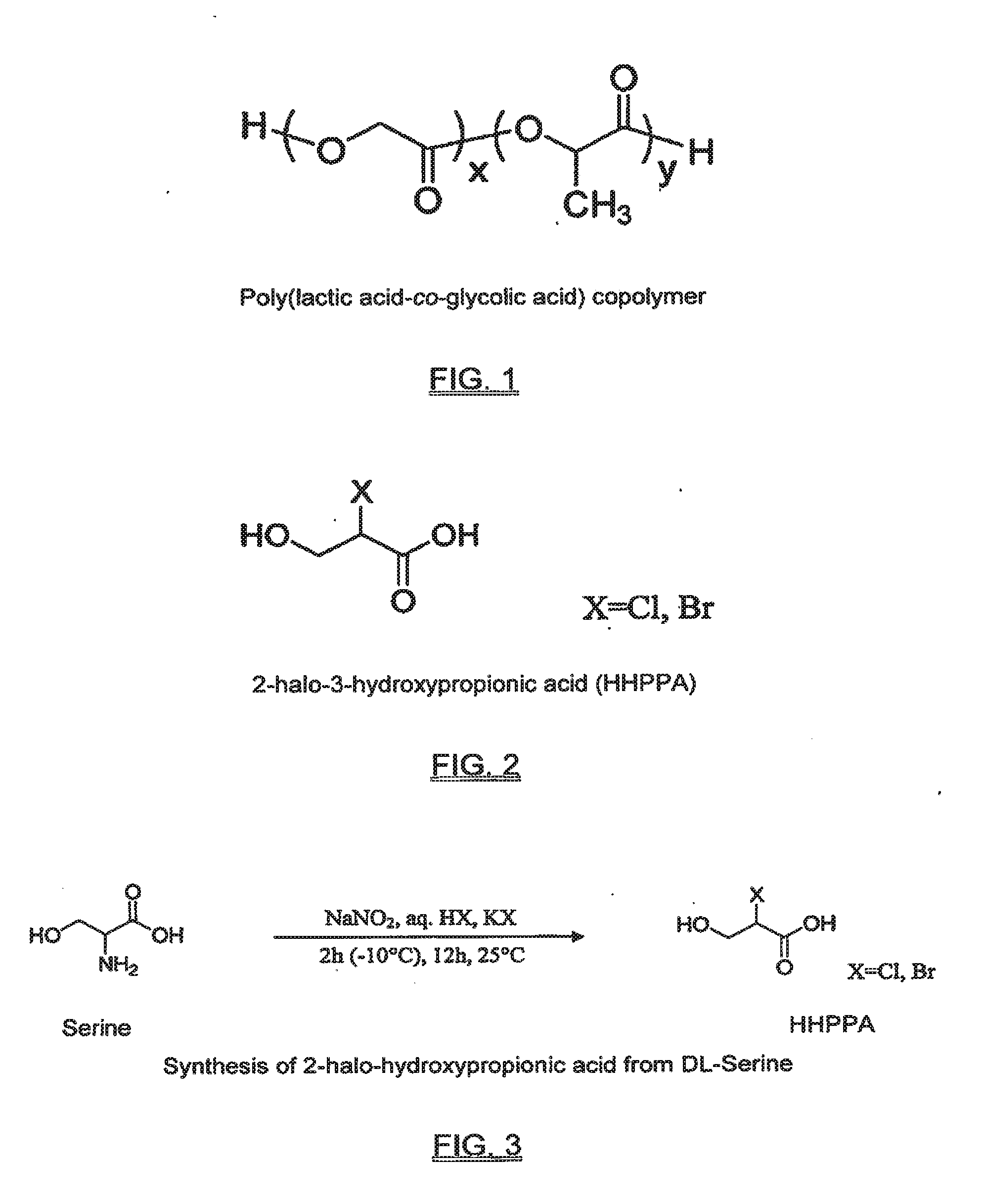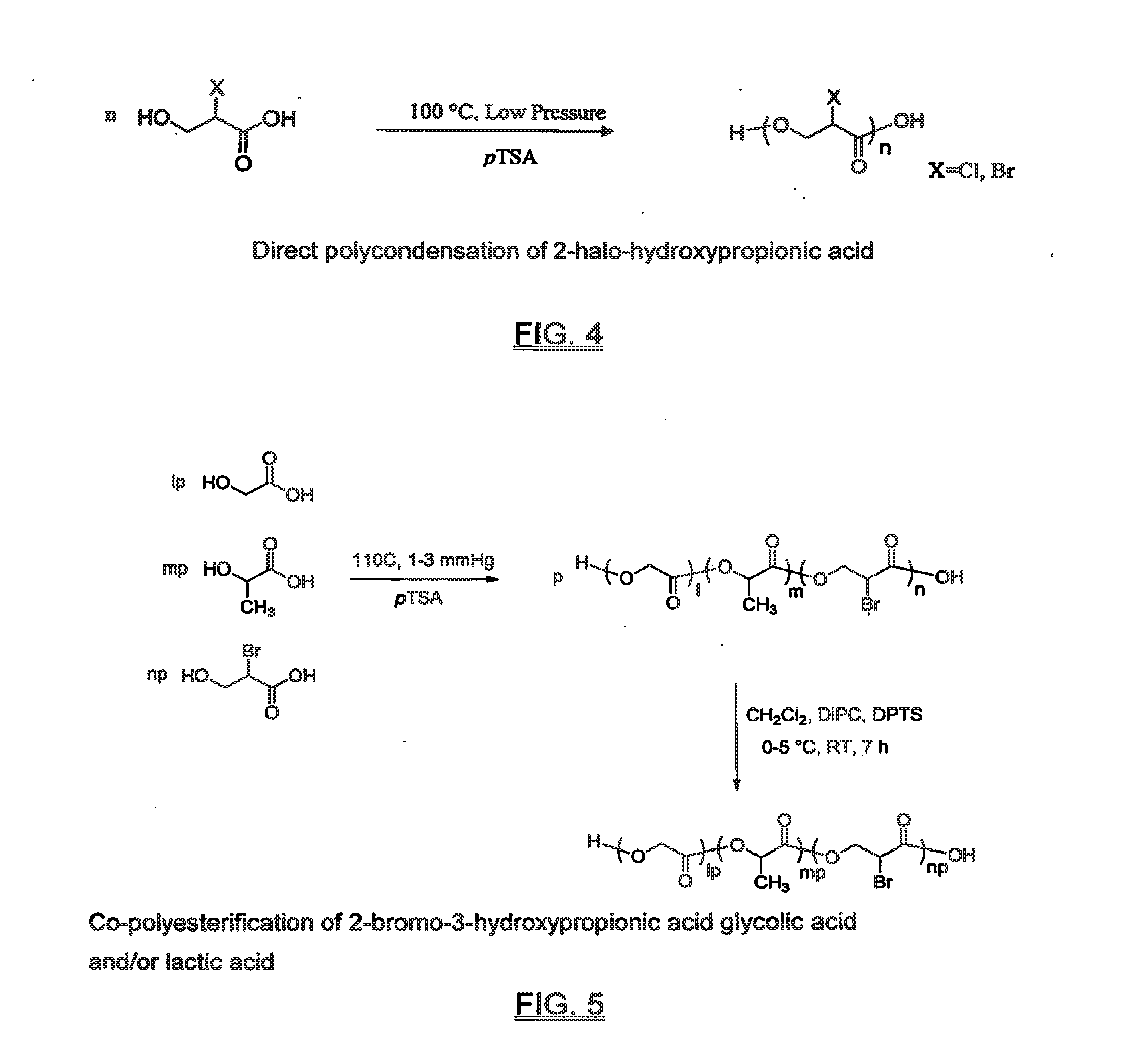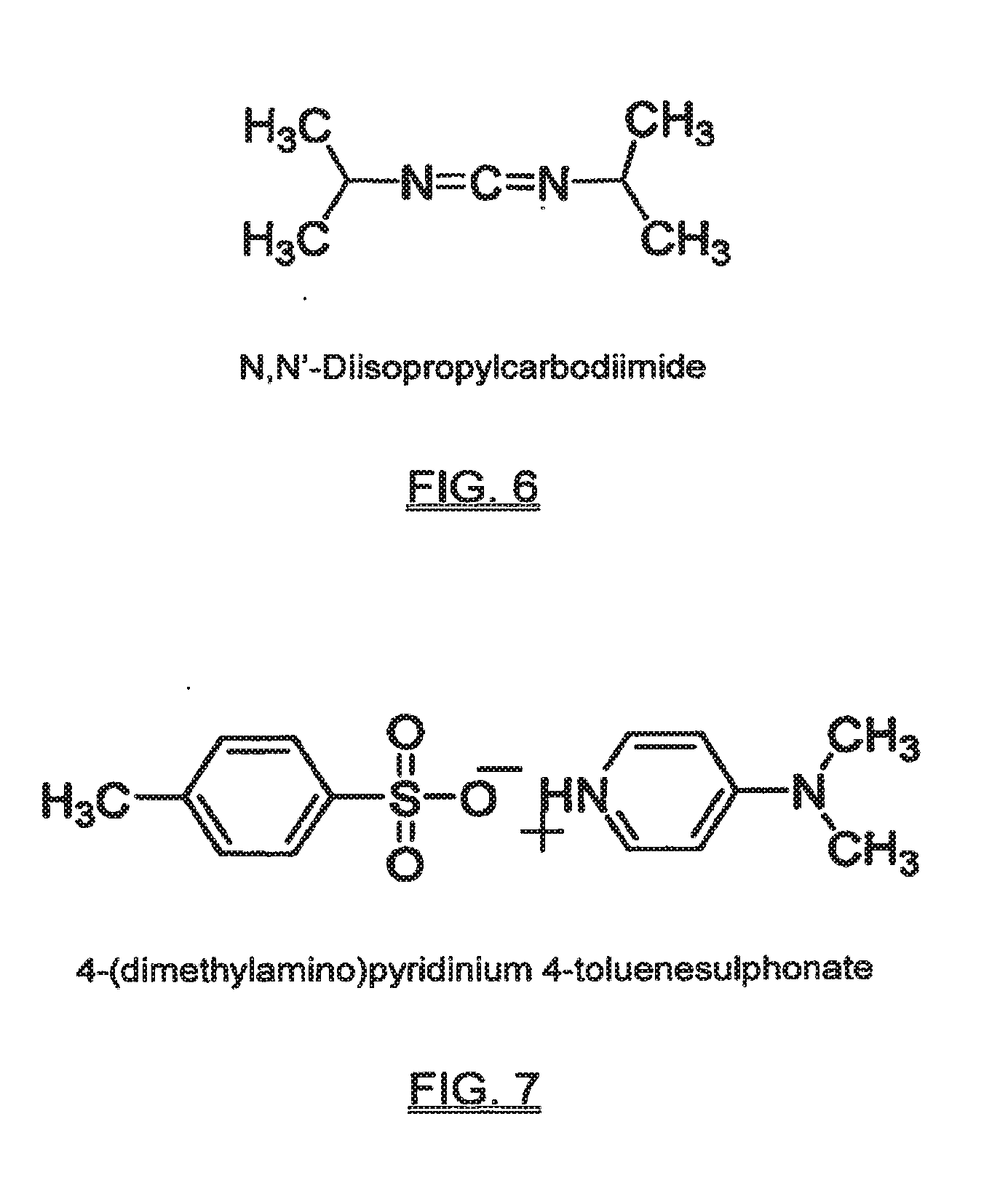Functional biodegradable polymers
a biodegradable polymer and polymer technology, applied in the field of biodegradable polyester polymers or copolymers, can solve the problems of major limitation, eliminating functionality, and inability to covalently attach drugs or other therapeutic molecules to make drug delivery devices
- Summary
- Abstract
- Description
- Claims
- Application Information
AI Technical Summary
Benefits of technology
Problems solved by technology
Method used
Image
Examples
example 1
Synthesis of 2-bromo-3-hydroxypropionic acid (FIG. 3)
[0049]NaNO2 (69 s, 1.0 mol) was added in 12 portions over three h to a cooled (−13° C.) solution of D,L-serine (53 g, 0.51 mol), potassium bromide (180 g; 1.5 mol), and hydrobromic acid (120 ml, 48 wt %, 1.0 mol) in distilled water (400 ml) that had been sparged with N2; the solution turned brown upon addition of NaNO2. The solution was warmed to room temperature (23° C.) and stirred for 16 h. It was then salted out with NaCl and extracted five times with ethyl acetate (100 mL ea). The aqueous layer was acidified with concentrated HBr to pH4. After filtration and removing the solvent by rotary evaporation, followed by drying under vacuum on a Schlenk line, the resulting yellow solid was recrystallized from CH2Cl2 to yield 55 g (64%) of 2-bromo-3-hydroxypropionic acid as a white crystalline solid; mp 48-51° C. 1H-NMR (CDCl3 / DMSO-d6): 3.58; (dd, CHH, 2J=11.8 Hz, 3 J=5.9 Hz), 3.71; (dd, CHH, 2J=11.6, 3J=7.5 Hz), 3.99; (dd, CHBr, 3J=7...
example 2
Synthesis of methyl 2-bromo-3-hydroxypropionate
[0051]Concentrated hydrobromic acid (10 drops) was added to a solution of 2-bromo-3-hydroxypropionic acid (10 g, 60 mmol) in methanol (80 mL, 2.0 mol). After refluxing the solution for 17 h, the solvent was removed using a rotary evaporator. The resulting oil was dissolved in CH2Cl2 (150 mL), and washed twice with aq NaHCO3 (75 mL ea) and once with brine (100 mL). The organic layer was dried over MgSO4. After filtration, the solvent was removed by rotary evaporation, and the residue was distilled (105-110° C. / 4 mm Hg) to yield 8.7 g (79%) of methyl 2-bromo-3-hydroxypropionate as a yellow oil. 1H NMR: 2.22; (br s, OH), 3.83; (s, CH3), 3.95; (dd, CHHOH, 2J=12.0 Hz, 3J=5.5 Hz), 4.06; (dd, CHHOH, 2J=12.1 Hz, 3J=7.4 Hz), 4.36; (dd, CHBr, 3J=5.6 Hz, 3J=7.4 Hz). 13C NMR: 44.4; (CHBr), 53.4; (CH3), 63.8; (CH2OH), 169.6; (C═O).
example 3
Synthesis of methyl 3-acetoxy-2-bromopropionate
[0052]A solution (total volume 10 mL) of acetyl chloride (4.2 mL, 31 mmol) in dry ether was added dropwise to an ice-cooled solution of methyl 2-bromo-3-hydroxypropionate (4.6 g, 25 mmol) and triethylamine (4.2 mL, 300 mmol) in dry ether (5 mL). The reaction was then warmed to room temperature (23° C.) and stirred for 16 h. The reaction was poured into ice water (200 mL) and extracted four times with ether (50 mL ea). The organic layers were combined and dried over MgSO4. After filtration, the solvent was removed by rotary evaporation, and the yellow residue was distilled (84-85° C. / 3 mm Hg) to yield 3.6 g (63%) of methyl 3-acetoxy-2-bromopropionate as a colorless oil. 1H NMR: 2.08; (s, CH3CO2), 3.82; (s, CH3O2C), 4.50-4.38; (m, CH2CHBr). 13C NMR: 20.8; (CH3CO2), 40.4; (CHBr), 53.4; (CH3O2C), 64.2; (CH2), 168.3; (CH3CO2), 170.21; (CO2CH3).
PUM
| Property | Measurement | Unit |
|---|---|---|
| molecular weight | aaaaa | aaaaa |
| temperature | aaaaa | aaaaa |
| temperature | aaaaa | aaaaa |
Abstract
Description
Claims
Application Information
 Login to View More
Login to View More - R&D
- Intellectual Property
- Life Sciences
- Materials
- Tech Scout
- Unparalleled Data Quality
- Higher Quality Content
- 60% Fewer Hallucinations
Browse by: Latest US Patents, China's latest patents, Technical Efficacy Thesaurus, Application Domain, Technology Topic, Popular Technical Reports.
© 2025 PatSnap. All rights reserved.Legal|Privacy policy|Modern Slavery Act Transparency Statement|Sitemap|About US| Contact US: help@patsnap.com



